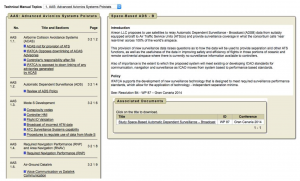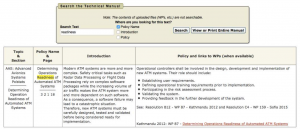55TH ANNUAL CONFERENCE, Las Vegas, USA, 14-18 March 2016WP No. 167Revision of Technical and Professional ManualPresented by TOC |
Summary
After the past 2015 Conference held in Sofia the TOC initiated a full revision of the TPM. Not only some of the contents but the structure of the Manual has been found as obsolete after the printed versions have given way to the electronic ones.
This paper proposes to initiate a revision of the structure of the TPM and the creation of a drafting group to update the contents.
Introduction
1.1 The Technical and Professional Manual (TPM) is the document where the policies of IFATCA are recorded.
1.2 As policies may become out of date with time it is important to review the TPM in order to have it as updated as possible.
Discussion
2.1 According to the Constitution of IFATCA Article VIII.4:
| The permanent record of the Federation’s policies and activity is contained in two volumes, the IFATCA Administrative Manual and the IFATCA Technical and Professional Manual. The Deputy President shall be responsible for ensuring the provisions of these Manuals are kept up-to-date by the regular issue of amendments (…) |
In practice the updating of the TPM is made in Conference by the Committees B and C which discuss the proposals of the Standing Committees TOC (Technical and Operational) and PLC (Professional and Legal).
2.2 Although the Standing Committees review old policies very often in order to update the TPM, this is generally only conducted when studying a particular topic, and a complete review has never been conducted.
2.3 Many old policies have been identified that require revision, including provisional policies that have never been adopted as full policy. All policies, including provisional, should be reviewed in order to ensure they are relevant, and upgrade to full policy where appropriate.
2.4 The current structure of the TPM is becoming obsolete primarily because it is developed for paper copies of the document. Digitized versions of the manual, including the online ‘ifatca.us’ version, are now used more frequently than paper copies.
2.4.1 The pdf version is distributed by the Office. It has several advantages over the paper version which is heavy and cumbersome compared to an electronic document that can be carried in a tablet or accessed online.
2.4.2 As in all e-documents the arguably most prominent feature of this electronic version is the possibility to search the document using a key word. This usually permits to find every relevant policy concerning a given subject with just a couple of searches, each of them lasting for a few seconds. A hard copy requires to check the index, figure out the section of the Manual where the relevant policy may be and read the alternatives until finding the correct one.
2.4.3 The PDF version of TPM is currently the one mostly used by Member Associations, Conference Directors, Executive Board members, IFATCA representatives and Standing Committee members.
2.4.4 The online version of the TPM that can be found in the www.ifatca.us website has become very popular among members due to its simplicity of use and the possibility to download the working papers related to the policy.
2.4.5 An example of the use of the online version is the following screen capture. The left column shows the titles of the policies included in one of the sections of the TPM (in this case the AAS, Advanced Avionics Systems section). Clicking on any of them the policy can be read on the right hand column that also includes a link to the associated documents.

2.4.6 The online version includes also the possibility to search the Manual using key words. The screen capture below provides an example where the word ‘readiness’ has been used to find a particular policy and one associated document.

2.5 The ease to find a policy in electronic versions of the TPM questions the current structure of the Manual. Some examples of the problems detected:
- The Technical part of the manual has 7 sections but it is not clear why this particular division was decided. The Helicopters section of the TPM, for example, has only 3 policies and the question of why a particular type of aircraft deserves a whole section of the Manual arises.
- Some policies could belong to different sections. For example there is a policy about Radar Monitoring (ATS 3.9) that is included in the ‘Matters Relating to Provision of ATS’ section but could also be included in the Surveillance section. Someone looking for this policy in a paper copy of the Manual could find it very difficult to locate.
- The scope of some sections is not evident. The ‘Advanced Avionics Systems’ is a good example. In practice this section has some policies that are difficult to classify but not properly about Avionics (see for example the policy about unmanned aircraft, AAS1.10).
2.6 The structure of the Manual could be changed to be adapted to the current way of working. While the current structure provides a unique identification for each policy many other systems could be used. A suggested alternate example is the use of a chronological system where the policy would be recorded under an index system including the year of the Conference where it was approved or updated thus making very easy to identify old policies. Some other possibilities could be developed.
2.7 While nothing is written about the structure of the TPM, any changes on it must be carefully planned to have a Manual easy to read and search. The Executive Board, as head of the Federation, should initiate the review of the structure of the TPM to decide the best way to fulfill the Federation needs.
Conclusions
3.1 The TPM is structured as a paper document while the electronic versions are at present the preferred ones.
3.2 The official version of the TPM is distributed by IFATCA in PDF format. In addition, the ‘ifatca.us’ website provides a searchable online version that is popular among members due to it’s ease of use.
3.3 The structure of the TPM may be subject to revision to adapt to the current situation.
3.4 The revision of the structure is to be undertaken at the direction of the EB.
3.5 A drafting group should be created to review the contents of the Manual being its duties:
– Identify policies that have become irrelevant for its deletion.
– Update terminology of the TPM.
– Identify policies which the content or intent needs to change.
3.6 The drafting group should ideally be composed of a small number of current or previous TOC/PLC members who have a detailed understanding of the TPM, and should continuously liaise with EVPT, EVPT and the respective chairs and members of TOC/PLC during the year.
Recommendations
It is recommended that;
4.1 Action item:
The EB initiate a review of the structure of the TPM to update its format to best suit an electronic document while having a proper unique way to identify every policy.
4.2 Action item:
A drafting group is created by the EB and tasked with:
– Identifying policies that have become irrelevant.
– Identifying policies with outdated terminology.
– Identifying policies which the content or intent needs to change.
– Proposing deletions, amendments or further study to the next conference, in order to address policies identified as per above.


